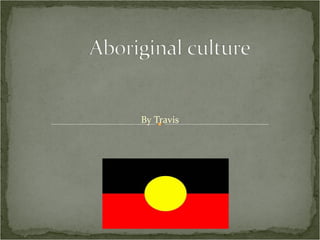
Travis 4 w aboriginal culture
- 1. By Travis
- 2. The Aboriginal people used to take as little as they could from the land because they thought they were part of the land. The Aboriginal people will always respect their land and sacred sites there were all different tribes. They stayed in their tribe area so that no fights would come to their area. Most of the Aboriginal people would tell religions like the whirlpool or the bat and the butterfly. We will tell more about Aboriginal people and their ways for the land they once roamed.
- 3. The Aboriginal people used to speak all different languages and they still do but there used to be hundreds but now there are only 200. The tribes all spoke differently so they tried to understand each when they were trading.
- 4. The Aboriginal people still do believe religions and spiritual beliefs they believe that their ancestral sprits made and formed the land. They believe in the Dreaming or the Dreamtime when the world was created they didn’t really believe in God. The story of the Dreamtime is still passed on by the elders of the tribe and stories were also told. One day all spiritual beliefs might become big stories for children.
- 5. The family life and roles are very important in Aboriginal families the men would hunt large animals and all the women would collect berries. They needed this for survival because no food would mean they would starve to death. This is why Aboriginal families have family life and roles just like we do in our ordinary family. This is the Aboriginal life and roles.
- 6. The Aboriginal people would hunt and collect their food on a daily basis and would never forget about collecting or hunting. The men hunted large animals such as emus ,kangaroos and goannas and maybe a few other animals. The women collected berries like raspberries and blueberries and some nuts to make damper. They would of collected seeds and other things like that maybe walnuts as well.
- 7. Implements and tools were very important to the Aboriginal people the women would use digging sticks for lizards and yams. They would use stone bashers to prepare foods such as seeds and different types of nuts. The men would use spears to hunt emus or kangaroos and other big animals there are more tools to come. A boomerang was used to injure emus or kangaroos so they can’t move which makes them easy to hunt.
- 8. The Aboriginal people would tell stories through music and art they would use didgeridoos to tell stories and only the men are allowed to use it. They also used clapping sticks in ceremonies with didgeridoos clapping sticks are a big part of Aboriginal music. Art was also used to tell stories like cave art and engravings. They all play a big part in telling stories about different things .
- 9. Aboriginal people have sacred places like Uluru which is a big sacred place there are many different sacred places. They could be anything even mountains rocks rivers and etc sometimes only the Aboriginal people are able to identify some of their sacred places. It is very important that we keep these sacred places for the sake of Aboriginal people. If we destroy these sacred places we might not find very important things like special weaved baskets.
- 10. Caption James Cook from England arrivied in Australia in 1770 even though the Aboriginal people had been living there for over 50 000 years. There were many problems between the Aboriginal people and the English people. Most of the new settlers came in 1788 just 18 years after Captain James Cook came to Australia. As the settlers grew most of the Aboriginal people were forced off their precious land.
- 11. The Aboriginal people today don’t need to collect or hunt food like they used to in the Dreamtime they can just buy food. The Aboriginal people have changed their life style and is so much easy to live now. Hopefully the Aboriginal people can live better then they used to but some might change there mind and to live the way they used to. The Aboriginal people are in a good community now then before.